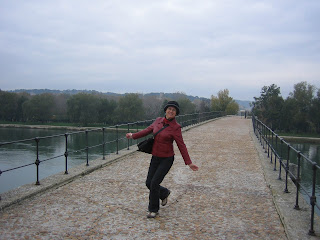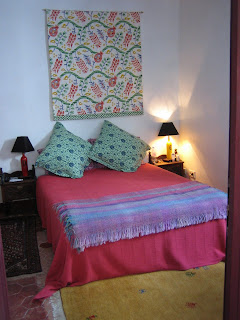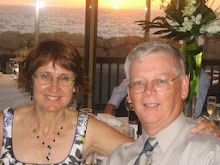 neighbours who sit in the sun each day just near our cottage. They appeared pretty pleased with these simple gifts and told us that we were very kind. We noticed when we greeted them the next day that the man (his name is Aldo) had his kangaroo brooch on his hat. They are lovely oldies and seem to enjoy passing the time of day with us. We talk about the weather or where we've been or plan to go.
neighbours who sit in the sun each day just near our cottage. They appeared pretty pleased with these simple gifts and told us that we were very kind. We noticed when we greeted them the next day that the man (his name is Aldo) had his kangaroo brooch on his hat. They are lovely oldies and seem to enjoy passing the time of day with us. We talk about the weather or where we've been or plan to go. Recently we have enjoyed two concerts. A recital at one of the community halls, given by a young woman from Entrecasteaux (une Entrecastelaine) who is studying singing at Nice. She was accompanied by a talented organist from Marseilles who, as part of the concert, played Ravel's Bolero - no mean feat for a single performer. The soprano performed an interesting repertoire - all French composers, with the exception of one dramatic piece by Kurt Weil - Je ne t'aime pas (I don't love you). We supported the local football team again last Sunday when they played in the village. An exciting game, but we lost again. En route home from the oval we met up with Jean-Paul, a Swiss man living in the village and friend of our landlord. He invited us in for an aperitif. We imbibed several glasses of rose whilst enjoying another interesting and cultural exchange with he and his wife Helena. Their very comfortable house is built in an old mill, the remnants of which (mill wheels, stone vats, etc.) are still there and provide an unique feature in a large room downstairs which houses a grand piano. They hold musical soirees regularly in their home and on Saturday evening we attended a piano recital.
Earlier this week we returned to the stunning natural landscape of the Gorges du Verdon and the pretty village of Moustiers Ste Marie with one of its churches almost suspended from a rocky cliff overlooking the village. The next day, on the recommendation of our elderly neighbours, we visited the Orthodox Monastere de St Michel du Var, a relatively new building (1980), in peaceful bushy surroundings, set back from the road between two villages . One of the young monks showed us around, but as well as the tour of the crypt and the church and a detailed explanation of the many modern religious frescoes, we received a lesson in theology. It was, at times, difficult to understand him although he spoke English. We were there for almost two hours. The tour was interrupted for 15 minutes during which there was a religious service. He told us that we were welcome to wait and afterwards continue the tour. As well as us there were only two others in the congregation. Six of the monastery residents, all clad in black, participated in the service which involved only singing and chanting - not one word was spoken by anyone for the whole time they were in the church. Afterwards our guide showed us the dining room with a long table set for 12 people. The walls of the room were lined with life size paintings of various French saints.
As planned, we headed to the first truffle market of the season in Aups. There was quite a bit of activity when we arrived. Not many stalls, but at each, a cluster of people, some serious buyers and others, like us, just curious onlookers. We saw two people being interviewed, while one seller holding a large truffle was being photographed. Obviously the start of the truffle season in France is much anticipated and generates a lot of media interest. One woman with three 100 euro notes in her hand was listening attentively to one of the stallholders
Not many stalls, but at each, a cluster of people, some serious buyers and others, like us, just curious onlookers. We saw two people being interviewed, while one seller holding a large truffle was being photographed. Obviously the start of the truffle season in France is much anticipated and generates a lot of media interest. One woman with three 100 euro notes in her hand was listening attentively to one of the stallholders  describing a recipe, ready to hand them over for some of the precious fungi lying in the basket before her. The going price today ... 400 euros per kg! Certainly the euro notes were flying and people were buying up big. Fran thought they smelt wonderful, Adrian ... not so sure.
describing a recipe, ready to hand them over for some of the precious fungi lying in the basket before her. The going price today ... 400 euros per kg! Certainly the euro notes were flying and people were buying up big. Fran thought they smelt wonderful, Adrian ... not so sure.
 Not many stalls, but at each, a cluster of people, some serious buyers and others, like us, just curious onlookers. We saw two people being interviewed, while one seller holding a large truffle was being photographed. Obviously the start of the truffle season in France is much anticipated and generates a lot of media interest. One woman with three 100 euro notes in her hand was listening attentively to one of the stallholders
Not many stalls, but at each, a cluster of people, some serious buyers and others, like us, just curious onlookers. We saw two people being interviewed, while one seller holding a large truffle was being photographed. Obviously the start of the truffle season in France is much anticipated and generates a lot of media interest. One woman with three 100 euro notes in her hand was listening attentively to one of the stallholders  describing a recipe, ready to hand them over for some of the precious fungi lying in the basket before her. The going price today ... 400 euros per kg! Certainly the euro notes were flying and people were buying up big. Fran thought they smelt wonderful, Adrian ... not so sure.
describing a recipe, ready to hand them over for some of the precious fungi lying in the basket before her. The going price today ... 400 euros per kg! Certainly the euro notes were flying and people were buying up big. Fran thought they smelt wonderful, Adrian ... not so sure. Afterwards en route home, we took a detour to La Site de St Barthelemy, the sign for which we had passed many times over the weeks.  We followed the narrow road for several kilometres to its end where we found a flat grassy area with picnic tables beside a stream with wooden bridges across it as well as a crossing made from large stepping stones. The stream emerged from a narrow chasm of sheer rock faces containing many caves. The only sound as we walked along the path was the rustling of leaves falling from the trees. We had the place to ourselves and it was beautifully tranquil. Well it was beautifully tranquil, until ... we were walking up the stone steps to the small church which gives the site its name.
We followed the narrow road for several kilometres to its end where we found a flat grassy area with picnic tables beside a stream with wooden bridges across it as well as a crossing made from large stepping stones. The stream emerged from a narrow chasm of sheer rock faces containing many caves. The only sound as we walked along the path was the rustling of leaves falling from the trees. We had the place to ourselves and it was beautifully tranquil. Well it was beautifully tranquil, until ... we were walking up the stone steps to the small church which gives the site its name.  Leading the way, Fran was startled to see un serpent (a snake) just centimetres from her feet, slithering along the next step. She almost fell down in her haste to escape. Fortunately Adrian was there to catch her. "I thought you told me they'd all be asleep at this time of the year!" she said accusingly. Obviously, this one was running behind schedule. Adrian was intrigued
Leading the way, Fran was startled to see un serpent (a snake) just centimetres from her feet, slithering along the next step. She almost fell down in her haste to escape. Fortunately Adrian was there to catch her. "I thought you told me they'd all be asleep at this time of the year!" she said accusingly. Obviously, this one was running behind schedule. Adrian was intrigued  and stopped to look at it, while Fran was making a bee-line for the car, all thought of sacred devotion and prayers of thanksgiving in the church were gone in a flash. Fight or flight? Adrian thought it was a case of - Squawk and walk!!
and stopped to look at it, while Fran was making a bee-line for the car, all thought of sacred devotion and prayers of thanksgiving in the church were gone in a flash. Fight or flight? Adrian thought it was a case of - Squawk and walk!!
 We followed the narrow road for several kilometres to its end where we found a flat grassy area with picnic tables beside a stream with wooden bridges across it as well as a crossing made from large stepping stones. The stream emerged from a narrow chasm of sheer rock faces containing many caves. The only sound as we walked along the path was the rustling of leaves falling from the trees. We had the place to ourselves and it was beautifully tranquil. Well it was beautifully tranquil, until ... we were walking up the stone steps to the small church which gives the site its name.
We followed the narrow road for several kilometres to its end where we found a flat grassy area with picnic tables beside a stream with wooden bridges across it as well as a crossing made from large stepping stones. The stream emerged from a narrow chasm of sheer rock faces containing many caves. The only sound as we walked along the path was the rustling of leaves falling from the trees. We had the place to ourselves and it was beautifully tranquil. Well it was beautifully tranquil, until ... we were walking up the stone steps to the small church which gives the site its name.  Leading the way, Fran was startled to see un serpent (a snake) just centimetres from her feet, slithering along the next step. She almost fell down in her haste to escape. Fortunately Adrian was there to catch her. "I thought you told me they'd all be asleep at this time of the year!" she said accusingly. Obviously, this one was running behind schedule. Adrian was intrigued
Leading the way, Fran was startled to see un serpent (a snake) just centimetres from her feet, slithering along the next step. She almost fell down in her haste to escape. Fortunately Adrian was there to catch her. "I thought you told me they'd all be asleep at this time of the year!" she said accusingly. Obviously, this one was running behind schedule. Adrian was intrigued  and stopped to look at it, while Fran was making a bee-line for the car, all thought of sacred devotion and prayers of thanksgiving in the church were gone in a flash. Fight or flight? Adrian thought it was a case of - Squawk and walk!!
and stopped to look at it, while Fran was making a bee-line for the car, all thought of sacred devotion and prayers of thanksgiving in the church were gone in a flash. Fight or flight? Adrian thought it was a case of - Squawk and walk!! Over the last few weeks Fran had joined a community singing group which met on Tuesday evenings in the hall - only one man with the rest being women of various ages. It was an interesting experience and another opportunity for her to mix with the locals and hear French spoken (at the usual rapid rate). They are planning to perform at a telethon on 5 December but she had to confess that she was leaving Entrecasteaux at the end of November.
On Saturday evening, before the piano recital, Fran said goodbye to the small church community of St Sauveur, who have welcomed her so warmly during our stay. Each week at the offertory she has sung a different hymn in English, unaccompanied, as requested by Pere Francois, the parish priest. Much to her surprise he thanked her in front of the congregation for her participation in the mass during her stay, remembering that we were leaving soon after.
Unfortunately the last few days have been somewhat marred by a medley of mundane matters, such as a washing machine that decided to give up the ghost (fortunately before the bowl filled with water) and a hot water system that packed it in - both on the same day. The latter was causing the electricity to cut out ,thrusting us into the dark and making preparing the meal  difficult. We rang our landlord in the US who suggested taking out the fuses one by one to see which was the rogue. It was the hot water fuse, unfortunately - Ooh la la!! On his recommendation, we rang Fred the plombier (plumber), a really pleasant young man who, after descending to the cave (cellar) and checking the hot water system, pronounced the verdict "Il est mort" (it's dead) and unable to be replaced until Saturday (this was on Thursday evening). As he spoke no English Fran had to explain the problems in French - another great opportunity to learn new vocabulary. Our new hot water system was installed on Saturday evening, not morning - C'est normale in France! Hot showers again - merveilleux!
difficult. We rang our landlord in the US who suggested taking out the fuses one by one to see which was the rogue. It was the hot water fuse, unfortunately - Ooh la la!! On his recommendation, we rang Fred the plombier (plumber), a really pleasant young man who, after descending to the cave (cellar) and checking the hot water system, pronounced the verdict "Il est mort" (it's dead) and unable to be replaced until Saturday (this was on Thursday evening). As he spoke no English Fran had to explain the problems in French - another great opportunity to learn new vocabulary. Our new hot water system was installed on Saturday evening, not morning - C'est normale in France! Hot showers again - merveilleux!
 difficult. We rang our landlord in the US who suggested taking out the fuses one by one to see which was the rogue. It was the hot water fuse, unfortunately - Ooh la la!! On his recommendation, we rang Fred the plombier (plumber), a really pleasant young man who, after descending to the cave (cellar) and checking the hot water system, pronounced the verdict "Il est mort" (it's dead) and unable to be replaced until Saturday (this was on Thursday evening). As he spoke no English Fran had to explain the problems in French - another great opportunity to learn new vocabulary. Our new hot water system was installed on Saturday evening, not morning - C'est normale in France! Hot showers again - merveilleux!
difficult. We rang our landlord in the US who suggested taking out the fuses one by one to see which was the rogue. It was the hot water fuse, unfortunately - Ooh la la!! On his recommendation, we rang Fred the plombier (plumber), a really pleasant young man who, after descending to the cave (cellar) and checking the hot water system, pronounced the verdict "Il est mort" (it's dead) and unable to be replaced until Saturday (this was on Thursday evening). As he spoke no English Fran had to explain the problems in French - another great opportunity to learn new vocabulary. Our new hot water system was installed on Saturday evening, not morning - C'est normale in France! Hot showers again - merveilleux! As for the washing machine, a phone call to the repairman revealed that it couldn't be fixed before we leave - "Pas possible, Madame...desole" (sorry). It's a pity that this happened just days before our departure. So we think it's time to head home.
We're leaving Entrecasteaux on Monday staying overnight in Orange, then Lyon, arriving in Paris on Wednesday and flying home late Sunday evening.

































